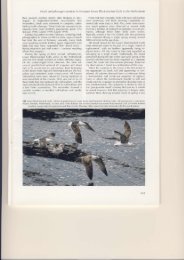Identification of American Herring Gull in a western European context
Identification of American Herring Gull in a western European context
Identification of American Herring Gull in a western European context
You also want an ePaper? Increase the reach of your titles
YUMPU automatically turns print PDFs into web optimized ePapers that Google loves.
<strong>Identification</strong> <strong>of</strong> <strong>American</strong> <strong>Herr<strong>in</strong>g</strong> <strong>Gull</strong> <strong>in</strong> a <strong>western</strong> <strong>European</strong> <strong>context</strong>38 <strong>American</strong> <strong>Herr<strong>in</strong>g</strong> <strong>Gull</strong> / Amerikaanse Zilvermeeuw Larus smithsonianus, first-w<strong>in</strong>ter, Boston, Massachusetts,USA, January 2001 (Killian Mullarney). Very dark-headed bird. Note rather ‘pla<strong>in</strong>’ rear-most (second generation)scapulars; also that one <strong>in</strong>ner median covert has been moulted. 39 <strong>American</strong> <strong>Herr<strong>in</strong>g</strong> <strong>Gull</strong> / AmerikaanseZilvermeeuw Larus smithsonianus, first-w<strong>in</strong>ter, Boston, Massachusetts, USA, January 2001 (Pat Lonergan). Not particularlypale-headed <strong>in</strong>dividual but note very solid-dark colouration on lower h<strong>in</strong>dneck, mantle and underparts.15










